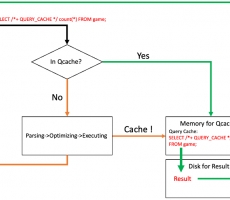-
Read More

QUERY CACHE Hint
Written by MinJong Kim on 12/09/2021 ABOUT QUERY CACHE With the release of CUBRID 11.0, the CUBRID DBMS supports QUERY CACHE hint. In this article, we will take some time to look at QUERY CACHE. 1. What is Query Cache? Query Cache is a DBMS feature that stores the statements together with the retrieved record set in memory using the SELECT query statement and returns the previously cached values when the identical query statement is requested. The query cache can be useful in an environment where you have tables that do not change very often and for which the server receives many identical queries. Queries using the QUERY_CACHE hint are cached in a dedicated memory area, and the results are also cached in separate disk space. Query Cache Features 1. The QUERY_CACHE hint only applies to SELE... -
Read More

TDE (Transparent Data Encryption) in CUBRID 11
Written by Jiwon Kim on 07/07/2021 👍Increase the level of database security by utilizing various security features of CUBRID. CUBRID 11 has enhanced security by providing the Transparent Data Encryption (henceforth, TDE) feature. So, what is TDE? TDE means transparently encrypting data from the user’s point of view. This allows users to encrypt data stored on disk with little to no application change. When a hacker hacks into an organization, the number one thing they want to steal is the important data in the database. Alternatively, there may be a situation where an employee with malicious intention inside the company logs into the database and moves all data to a storage media such as a USB. The easiest way to protect data in these situations is to encrypt the database. TDE, a technolog... -
Read More

Understanding JDBC Internals & Timeout Configuration
Written by Woon Duk Kang on 06/07/2017 An application with a proper JDBC timeout can cut down the failure time. In this article, we would like to talk about different kinds of timeout values and recommended timeout application methods when you import values from DBMS. Web Application Server became unresponsive after a DDoS attack one day (This is a close reconstitution of an actual event.) The entire service did not work normally after a DDoS attack. The network was disconnected because L4 was not working, which caused WAS to be inoperable as well. Shortly afterward, the security team blocked all DDoS attacks and restored the network back to normal. Yet, WAS was still not working. Through the ThreadDump of WAS, the service team was able to confirm that WAS had stopped during API call from... -
Read More

Understanding JVM Internals
Written by Se Hoon Park on 05/30/2017 Every developer who uses Java knows that Java bytecode runs in a JRE (Java Runtime Environment). The most important element of the JRE is Java Virtual Machine (JVM), which analyzes and executes Java byte code. Java developers do not need to know how JVM works. So many great applications and libraries have already been developed without developers understanding JVM deeply. However, if you understand JVM, you will understand Java more, and will be able to solve the problems which seem to be so simple but unsolvable. Thus, in this article I will explain how JVM works, its structure, how it executes Java bytecode, the order of execution, examples of common mistakes and their solutions, as well as the features in Java SE 7 Edition. Virtual Machine The JRE ... -
Read More

Understanding TCP/IP Network Stack & Writing Network Apps
Written by Hyeongyeop Kim on 06/09/2017 We cannot imagine Internet service without TCP/IP. All Internet services we have developed and used at NHN are based on a solid basis, TCP/IP. Understanding how data is transferred via the network will help you to improve performance through tuning, troubleshooting, or introduction to a new technology. This article will describe the overall operation scheme of the network stack based on data flow and control flow in Linux OS and the hardware layer. Key Characteristics of TCP/IP How should I design a network protocol to transmit data quickly while keeping the data order without any data loss? TCP/IP has been designed with this consideration. The following are the key characteristics of TCP/IP required to understand the concept of the stack. TCP and IP ...



